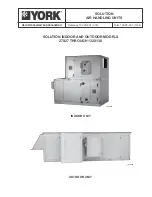
YORK INTERNATIONAL
8
STORAGE
Short-term Storage
Short-term storage is considered six (6) months or less
from date of shipment. Storage maintenance during this
time period is usually limited to the following.
1. If the units are to be stored out-of-doors, prior to
installation within the building, special care must be
taken to cover and protect the units from dust, rain,
snow and rodents. The units must be protected from
constant exposure to rain and snow.
Under no circumstances should out-
door storage be used for a period of
more than one week.
2. Store on a firm, flat surface to prevent distortion.
3. The unit must also be protected from damage to
the exterior of the cabinet or coil connections by
construction vehicles and personnel.
Long-term Storage
Long-term storage is considered to be any period be-
yond six (6) months from date of shipment. If long-
term storage is anticipated,
contact the YORK Sales
Office at time of order entry for the proper in-
structions and requirements for long-term stor-
age.
It is mandatory that a detailed record be main-
tained during this long-term period, such as, but not lim-
ited to: proper sealing of the cabinet, rotation of the
blowers and bearings, and protection of all motors from
moisture. Refer to Form 50.20-NM3.
By adhering to the Long-term Storage procedures, the
standard warranty of 12 months from date of startup
applies. However, it may not exceed 36 months from
date of shipment.
It will be the responsibility of the cus-
tomer to submit a monthly log sheet
(MS577) showing the condition of the
unit and noting any discrepancies. A
copy of the log sheet should be sent to
the A.S. District Office, attn: Sales
Person.
Failure to perform the long-term
storage requirements will void the
warranty.
SAFETY PRACTICES
Air Handling Units are designed to provide safe and
reliable service when operated within design specifica-
tions. To avoid injury to personnel and damage to equip-
ment or property when operating this equipment, use
good judgement and follow safety practices as outlined
below.
CHECK the assembly and component
weights to be sure rigging equipment
can handle them safely. Note the cen-
ters of gravity and any specific rig-
ging instructions.
NEVER enter an enclosed fan cabi-
net or reach into unit while the fan is
running.
Lock open and tag
the fan motor power disconnect
switch before working on fan. Take fuses with you and
note removal on lock open tag.
Lock open and tag
the electric heat power discon-
nect switch before working on or near heaters.
Check
for adequate ventilation so that fumes will not
migrate through ductwork to occupied spaces when
welding or cutting inside Air Handling unit of HVAC
system.
When steam cleaning coils,
be sure that the area is
clear of personnel to avoid danger.
Do not
remove access panel fasteners until fan is com-
pletely stopped. Pressure developed by a moving fan
can cause excessive force against the panel toward
personnel.
Do not
work on dampers until their operators or link-
age is disconnected.
Be sure
fans are properly grounded before working
on them.
Secure
drive sheaves before working on a fan to en-
sure that rotor cannot free-wheel.
Do not
restore power to unit until temporary walkways
inside components have been removed.
Never
pressurize equipment in excess of specified test
pressures and be sure correct dampers are open.
Protect
adjacent flammable material when welding or
cutting. Have a fire extinguisher ready for immediate
use.
Introduction
































